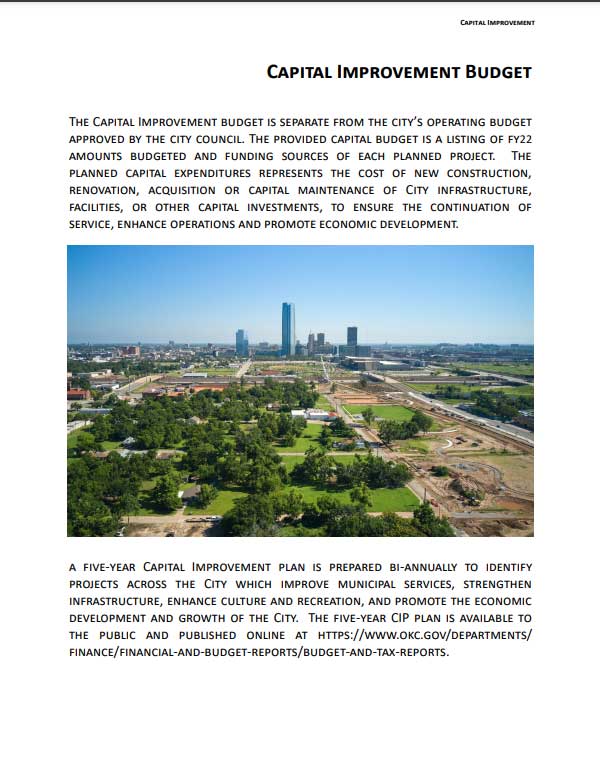The City of Oklahoma City, Oklahoma, faces several significant infrastructure challenges that impact the daily lives of its residents. One of the most pressing issues is the need to modernize and expand the city’s transportation system, including roads, highways, and public transit, to reduce traffic congestion and improve safety. Additionally, Oklahoma City’s aging water and sewer systems require significant investment and upgrades to maintain reliable service and avoid potential health hazards. The city also needs to invest in affordable housing developments and improve access to high-speed internet to support economic growth and improve the quality of life for its residents. Addressing these challenges will require collaboration and investment from local and state officials and private sector stakeholders.
City of Oklahoma City, Oklahoma
Population (Year): 681100 (2020)

Sample Highlights from the Capital Improvement Plan
Project ID
Project Title
Project Start Year
Project Description
Project Spend Total
Page Ref
Project Satus
569593
“Indiana/Linwood Bike Lanes – N Indiana Avenue from NW 19th Street to Linwood Boulevard.; Linwood Boulevard from N Indiana Avenue to N Shartel Avenue (Ward 6)”
2023
“Tier 1, Tier 2, and Tier 3 bike facilities project for the Better Streets Safer Sales Tax Program. Estimated
annual operating cost is $0. ”
591150
47
Ongoing
569597
NE 23rd Streetscape – NE 23rd Street from Kelley to Miramar/KatyTrail (Ward 7)
2023
Resurfacing, sidewalk, and pedestrian safety improvements at intersections. Estimated annual operating cost is $0.
1000000
48
Ongoing
569664
Britton, Piedmont to N Mustang – W Britton Rd from Piedmont Rd (Hwy 4) to N Mustang Rd (Ward 1)
2023
“Reconstruction, construction, repair, resurfacing, or improvements of street, may include AE, signals,
signs, markings, devices, conduit, lighting, drainage, intersection imprv, ROW, utilities, sidewalks,
furniture, landscaping, or irrigation sys. Estimated annual operating cost is $0. ”
555000
52
Ongoing
569870
Existing Atoka Pipeline – Lake Atoka to Lake Stanley Draper (Citywide)
2023
Maintenance and repair of the existing raw water pipeline. Estimated annual operating cost is $0.
15463000
75
Ongoing
569876
Hefner WTP Upgrades – 3827 W. Hefner Road (Ward 8)
2023
“Improvements to the Hefner Water Treatment Plant to meet regulatory requirement and maintain
reliable operation. Estimated annual operating cost is $0. ”
103000
76
Ongoing
Explore all options available to you!
Citylitics offers access to over 30,000 unique locations across North America through our Capital Projects Dashboard (CPD).
Capital Projects Dashboard (CPD) provides a comprehensive market view of all planned infrastructure spend in one single view with powerful filters such as: population, project value, fiscal year, project status, project description, geography, and more. The dashboard will help identify opportunity hot spots, create data-driven forecasts you can be confident in with bottom-up data for the next 5 years of planned infrastructure spend, and uncover true market needs.
How to Read a Capital Improvement Plan (CIP) for Business Development?
When a city, municipality or state issues a Capital Improvement Plan (CIP), it can be overwhelming and daunting, but there are a few key things you need to investigate. Let’s start with the definition of CIP – A Capital Improvement Plan (CIP) contains all the individual capital projects, equipment purchases, and major studies for a local government; in conjunction with construction and completion schedules, and in consort with financing plans. The plan provides a working blueprint for sustaining and improving the community’s infrastructures. It coordinates strategic planning, financial capacity, and physical development. A CIP stands at the epicenter of a government’s Planning, Public Works, and Finance departments. When a CIP is issued, it typically includes the following information:
- A listing of the capital projects or equipment to be purchased
- The projects ranked in order of preference
- The plan for financing the projects
- A timetable for the construction or completion of the project
- Justification for the project
- Explanation of expenses for the project
Now, for business development, while the capital plan is interesting, the capital program is for capital expenditures that extends five to ten years beyond the capital budget. Knowing the difference is important so you can influence upcoming program versus just responding to an RFP. If reading the CIP makes your head explode, or you want to save time, Request a Demo of Citylitics CIP dashboard with over 20,000 CIPs from USA and Canada. Citylitics has 20,000 plus available CIPs, how can we help you? What states, cities or counties are you looking to improvement your business development, we can assist you in influencing an upcoming RFP versus simply responding to an RFP. Citylitics Capital Projects Dataset is a comprehensive resource for businesses and organizations looking to track and analyze planned infrastructure spend in their area. The dataset offers a range of features and benefits, including:
- Comprehensive Market View: The dataset provides a single view of all planned infrastructure spend, with powerful filters such as population, project value, fiscal year, project status, project description, geography, and more. This allows businesses to gain a comprehensive understanding of the market and identify new opportunities.
- Identify Opportunity Hot Spots: The dataset offers map views and filters that allow users to identify opportunity hot spots where they need to allocate resources. This helps businesses to understand where they should focus their efforts to achieve the best results.
- Create Data-Driven Forecasts: The dataset provides bottom-up data for the next 5 years of planned infrastructure spend, allowing businesses to create data-driven forecasts they can be confident in.
- Uncover True Market Needs: The dataset allows businesses to develop long-term business plans, R&D, and growth initiatives based on true, bottom-up market needs instead of opinions and anecdotes. This helps businesses to make more informed decisions and achieve better results.
With Citylitics Capital Projects Dataset, businesses can gain a deeper understanding of planned infrastructure spend in their area, which can help them to identify new opportunities and make more informed decisions.
